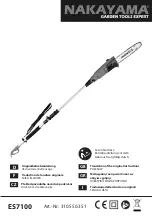
Powercraft
11
•
Slowly saw into the workpiece at an angle, moving the saw to a vertical position and
continue to saw along the cutting line.
•
Switch the saw off and lift off the workpiece when the work is complete.
Flush sawing
•
Elastic bi-metal saw blades allow you to saw projecting objects (e,g, water pipes, iron
bars, etc,) flush against the wall.
•
Apply the saw blade directly to the wall and bend slightly so that the footplate rests
against the wall.
•
Switch the machine on and saw off the workpiece keeping constant lateral pressure
against the wall.
There are no user servicable parts in this unit. Any repairs or servicing should be carried out by
qualified service en-gineers.
Troubleshooting
Repairing of electric appliances may be carried out only by experts.
Make sure that the plug is removed from the mains when carrying out
maintenance work on the motor.
The machines have been designed to operate over a long period of time with a minimum of
maintenance. Continuous satisfactory operation depends upon proper machine care and
regular cleaning.
4. SERVICE & MAINTENANCE
• The electromotor gets hot
• The connected machine
does not work
• The cool ventilation slots in
the motor are stopped up
with dirt.
• The motor is defect.
• Interruption in the mains
connection.
• Clean the cool ventilation
slots.
• Have your machine
repaired or checked by
your local Ferm dealer.
• Check mains connection
for fracture.
Have your machine
repaired/checked by your
local Ferm dealer.
GB
06
Powercraft
c.
Keep children and bystanders away while operating a power tool. Distractions can cause
you to lose control.
2) Electrical
safety
a.
Power tool plugs must match the outlet. Never modify the plug in any way. Do not use any
adapter plugs which earthed (grounded) power tools. Unmodified plugs and matching
outlets will reduce risk of electric shock.
b. Avoid body contact with earthed or grounded surfaces such as pipes, radiators, ranges
and refrigerators. There is an increased risk of electric shock if your body is earthed or
grounded.
c.
Do not expose power tools to rain or wet conditions. Water entering a power tool will
increase the risk of electric shock.
d. Do not abuse the cord. Never use the cord for carrying, pulling or unplugging the power
tool. Keep cord away from heat, oil, sharp edges or moving parts. Damaged or entangled
cords increase the risk of electric shock.
e.
When operating a power tool outdoors, use an extension cord suitable for outdoor use.
Use of a cord suitable for outdoor use reduces the risk of electric shock. Always use tool in
conjunction with a residual circuit breaker device.
3) Personal
safety
a.
Stay alert, watch what you are doing and use common sense when operating a power
tool. Do not use a power tool while you are tired or under the influence of drugs, alcohol or
medication. A moment of inattention while operating power tools may result in serious
personal injury.
b. Use safety equipment. Always wear eye protection. Safety equipment such as dust
mask, non-skid safety shoes, hard hat, or hearing protection used for appropriate
conditions will reduce personal injuries.
c.
Avoid accidental starting. Ensure the switch is in the off position before plugging in.
Carrying power tools with your finger on the switch or plugging in power tools that have
the switch on invites accidents.
d. Remove any adjusting key or wrench before turning the power tool on. A wrench or a key
left attached to a rotating part of the power tool may result in personal injury.
e.
Do not overreach. Keep proper footing and balance at all times. This enables better
control of the power tool in unexpected situations.
f.
Dress properly. Do not wear loose clothing or jewellery. Keep your hair, clothing and
gloves away from moving parts. Loose clothes, jewellery or long hair can be caught in
moving parts.
g. If devices are provided for the connection of dust extraction and collection facilities,
ensure these are connected and properly used. Use of these devices can reduce dust
related hazards.
h.
Use clamps or a vice to hold work. It’s safer than using your hand and it frees both hands to
operate tool.
4)
Power tool use and care
a.
Do not force the power tool. Use the correct power tool for your application. The correct
power tool will do the job better and safer at the rate for which it was designed.
b. Do not use the power tool if the switch does not turn it on and off. Any power tool that
cannot be controlled with the switch is dangerous and must be repaired.
GB


























